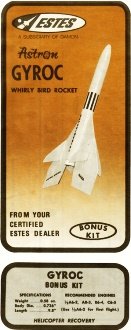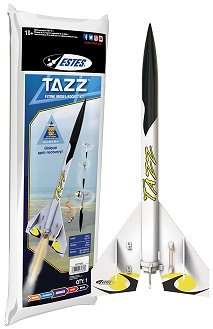|
Rocket Models & History
(content generated by ChatGPT)

Estes Astron Gyroc model rocket with spin recovery.
The Estes Astron Gyroc model rocket, introduced
in the late 1960s, is a fascinating example of ingenuity in model rocketry. It was
designed to demonstrate an innovative recovery method - spin recovery - that set
it apart from traditional parachute or streamer recovery systems. The Gyroc became
an instant hit among rocketeers due to its simplicity, affordability, and the spectacle
of its recovery mechanism in action. A newer version called the "Tazz" is now being sold. It simplifies
the building process.
Development History
The Gyroc was developed during a period when Estes Industries sought to expand
the educational and recreational aspects of model rocketry by introducing kits with
unique recovery mechanisms. Designed by Vernon Estes and his team, the Gyroc was
intended to showcase principles of aerodynamics and gyroscopic forces while providing
an engaging user experience. The model rocket's design incorporated a streamlined
fuselage and lightweight fins, optimizing it for stable flight during ascent and
controlled descent.
The Gyroc's introduction coincided with a boom in model rocketry, fueled by interest
in space exploration and technological advancement. It was marketed as an entry-level
kit that offered something different from the conventional recovery methods, making
it both educational and entertaining for young rocketeers.

Estes Tazz
model rocket featuring spin recovery - a replacement for the Gyroc. It was obviously
named after the
Tasmanian
Devil cartoon character.
Technical Design and Spin Recovery System
The most distinctive feature of the Gyroc was its spin recovery system. Unlike
rockets that descend under a parachute or streamer, the Gyroc's fins were hinged
and folded outward during descent, creating an autorotation effect that slowed its
fall and stabilized the rocket. This innovative system eliminated the need for complex
recovery components like parachutes, reducing weight and assembly time.
Here's how the spin recovery mechanism works:
Ascent Phase: During launch, the Gyroc behaves like any standard model rocket.
Its hinged fins are locked into a fixed position, ensuring stability and aerodynamic
efficiency.
Ejection Phase: At the apogee, the engine's ejection charge triggers the release
of the locking mechanism on the fins.
Descent Phase: As the rocket begins its descent, the hinged fins swing outward
due to gravity and aerodynamic forces. This configuration induces a spinning motion,
similar to the blades of an autogyro. The rotational force creates lift and drag,
significantly reducing the rocket's terminal velocity and ensuring a gentle landing.
The simplicity and effectiveness of this system made the Gyroc a popular choice
for hobbyists interested in exploring alternative recovery methods. It also served
as an excellent teaching tool for illustrating principles of rotational dynamics
and drag-induced deceleration.
Model Rocketeer Use
The Gyroc gained a loyal following among model rocketeers for several reasons.
Its unique recovery mechanism provided a memorable and visually striking demonstration,
especially for spectators watching the rocket's descent. Hobbyists appreciated its
ease of assembly and the lack of reliance on fragile components like parachutes,
which were prone to tangling or tearing.
In competitions, the Gyroc was often used in events where innovative recovery
techniques were celebrated. Its design encouraged experimentation, with some enthusiasts
modifying the rocket to optimize its spin rate or enhance its aesthetic appeal.
The Gyroc also found a place in educational settings, where teachers used it to
engage students in discussions about aerodynamics and mechanical systems.
Although the Gyroc is no longer in production, it remains a beloved classic in
the model rocketry community. Vintage kits and custom-built replicas are still flown
by enthusiasts who admire its ingenious design and the engineering principles it
embodies. Its legacy endures as a testament to the creativity and educational value
that Estes Industries brought to the field of model rocketry.
 This
content was generated by primarily the ChatGPT (OpenAI),
and/or Gemini (Google),
and/or Arya (GabAI),
and/or Grok
3 (x.AI)
artificial intelligence (AI) engine. Some review was performed to help detect
and correct any inaccuracies; however, you are encouraged to verify the
information yourself if it will be used for critical applications. In some
cases, multiple solicitations to the AI engine(s) was(were) used to assimilate
final content. Images and external hyperlinks have also been added occasionally.
Courts have ruled that AI-generated content is not subject to copyright
restrictions, but since I modify them, everything here is protected by RF Cafe
copyright. Many of the images are likewise generated and modified. Your
use of this data implies an agreement to hold totally harmless Kirt
Blattenberger, Airplanes and Rockets, and any and all of its assigns. Thank you.
Here are the major categories: This
content was generated by primarily the ChatGPT (OpenAI),
and/or Gemini (Google),
and/or Arya (GabAI),
and/or Grok
3 (x.AI)
artificial intelligence (AI) engine. Some review was performed to help detect
and correct any inaccuracies; however, you are encouraged to verify the
information yourself if it will be used for critical applications. In some
cases, multiple solicitations to the AI engine(s) was(were) used to assimilate
final content. Images and external hyperlinks have also been added occasionally.
Courts have ruled that AI-generated content is not subject to copyright
restrictions, but since I modify them, everything here is protected by RF Cafe
copyright. Many of the images are likewise generated and modified. Your
use of this data implies an agreement to hold totally harmless Kirt
Blattenberger, Airplanes and Rockets, and any and all of its assigns. Thank you.
Here are the major categories:
Airplane Models & History |
Helicopter Models & History |
Rocket Models & History | Aeronautical &
Aerospace History | Aeronautical &
Aerospace Companies | Aeronautical & Aerospace Pioneers |
Aeronautical & Aerospace
Terms & Definitions
|



